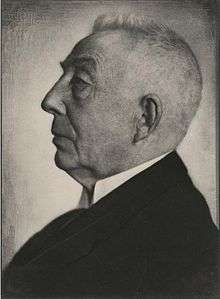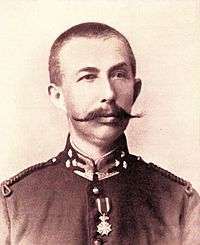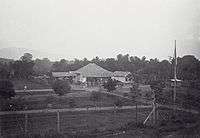Hendrikus Colijn
| Hendrikus Colijn | |
|---|---|
 Colijn | |
| 29th and 32nd Prime Minister of the Netherlands | |
|
In office 26 May 1933 – 10 August 1939 | |
| Monarch | Wilhelmina |
| Preceded by | Charles Ruijs de Beerenbrouck |
| Succeeded by | Dirk Jan de Geer |
|
In office 4 August 1925 – 8 March 1926 | |
| Monarch | Wilhelmina |
| Preceded by | Charles Ruijs de Beerenbrouck |
| Succeeded by | Dirk Jan de Geer |
| Personal details | |
| Born |
22 June 1869 Burgerveen, Netherlands |
| Died |
18 September 1944 (aged 75) Ilmenau, Germany |
| Political party | ARP |
| Spouse(s) | Helena Groenenberg (1867-1947) |
| Children | 3 |
| Occupation | Military Officer |
| Religion | Reformed |
| Signature |
 |
Hendrikus "Hendrik" Colijn (22 June 1869 – 18 September 1944) was a Dutch soldier, businessman and politician who was Prime Minister of the Netherlands from 1925 to 1926 and again from 1933 to 1939.
Early life
He was born on 22 June 1869 in the Haarlemmermeer to Antonie Colijn and Anna Verkuijl, who had migrated to the newly created Haarlemmermeer polder from the Land of Heusden and Altena for religious reasons. He was the first of six children, all born in Haarlemmermeer. Colijn grew up in the Land of Altena.
Military service


At the age of 16, he went to a Military Academy in Kampen for officer training, where he graduated as a 2nd Lieutenant in 1892. In 1893, he married Helena Groenenberg and was sent to the Dutch East Indies. During his 16 years in the Dutch East Indies, he spent ten years in the Colonial Army, serving in the Aceh War as the lieuteant of J. B. van Heutsz, and six further years in the Colonial administration, having the same role towards van Heutsz when the latter became Governor General in 1904.
Colijn's letters to his wife from his period on Lombok reveal his participation in acts of brutality which by modern standards would be considered severe war crimes:
- "I have seen a mother carrying a child of about 6 months old on her left arm, with a long lance in her right hand, who was running in our direction. One of our bullets killed the mother as well as the child. From now on we couldn't give any mercy, it was over. I did give orders to gather a group of 9 women and 3 children who asked for mercy and they were shot all together. It was not a pleasant job, but something else was impossible. Our soldiers tacked them with pleasure with their bayonets. It was horrible. I will stop reporting now."[1]
Political life
After his return to the Netherlands in 1909, he was elected as an Anti Revolutionary Party Member of Parliament for the district Sneek (Before 1918, the Dutch voting system was the same as the British).
In 1911, he was appointed Minister of War and revised the Dutch Selective Service System. In May 1918 he acted as an intermediary between the British and Kaiser Wilhelm II of Germany to arrange an armistice, resulting in the Kaiser getting refuge in The Netherlands.
Business life
In 1910 the Holland Dakota Landbouw Compagnie is established[2] with Hendrikus Colijn and his brother nl:Arie Colijn as the primary share holders'".[3]
From 1914 to 1922 he served as CEO for the Bataafse Petroleum Maatschappij (BPM). In 1925, he also became CEO of Royal Dutch Shell.
Prime minister
In 1922 he accepted the political leadership of the Anti Revolutionary Party (Calvinist) from Dr. Abraham Kuyper. Between 1925-1926 and 1933-1939 he served five times as Prime Minister. During the 1930s his government faced the effects of the Great Depression, which took a heavy toll on the Netherlands. Colijn's government responded to the economic crisis with a very strict fiscal policy, which may have further weakened the Dutch economy. Colijn's decision to adhere to the Gold Standard until 1937, long after most of the trading partners of the Netherlands had dropped it, also played a role in lengthening the economic crisis. In 1939, his latest cabinet, with Protestant and liberal ministers but without Catholic ministers, lasted only three days before a government crisis. From 1927-1929, he also was head of the Dutch delegation to the League of Nations in Geneva.
World War II and death
After the Dutch defeat in the Battle of the Netherlands in 1940, he published an essay entitled "On the Border of Two Worlds",[4] in which he called for accepting German leadership in Europe, immediately after the Royal House had fled to England, leaving him behind. His view was influenced by the tremendous show of force the German blitzkrieg had shown and the relative weakness of the Allied forces. Soon thereafter, he tried to organize political resistance but was arrested in June 1941 and taken to Berlin for interrogation. The Germans tried to have him confess that he had conspired with the British to invade the Netherlands to serve as an excuse for the German invasion.
Late in the war after the tide had turned against the Germans, according to a grandson, Himmler wanted to keep Colijn available as a possible intermediary with the British, as he had done earlier for Wilhelm II. The very fact that the Gestapo allowed the visit suggests that Himmler was already making contingency plans in case of a German loss. In March 1943 Colijn was put under house arrest in a remote mountain hotel in Ilmenau, where he died on 18 September 1944".[5][6]
References
- ↑ Introduction to the History of the Dutch East Indies
- ↑ Zeeland Middelburgsche Courant, June 6, 1910, page 7
- ↑ Antonie Colijn (1870-1932). Farmer, farmer leader, mayor by P.E. Workman and R.E. van der Woude, pp. 151-176
- ↑ DE GRENS V A N TWEE WERELDEN
- ↑ Documentation Centre (PDC) of Leiden University
- ↑ Oral History Hendrik "Henk" Colijn
| Wikimedia Commons has media related to Hendrikus Colijn. |
| Political offices | ||
|---|---|---|
| Preceded by Simon de Graaff |
Minister of Colonial Affairs (interim) 1925 |
Succeeded by Charles Welter |
| Preceded by Charles Ruijs de Beerenbrouck |
Prime Minister of the Netherlands 1925-1926 |
Succeeded by Dirk Jan de Geer |
| Preceded by Simon de Graaff |
Minister of Colonial Affairs 1933-1937 |
Succeeded by Charles Welter |
| Preceded by Charles Ruijs de Beerenbrouck |
Prime Minister of the Netherlands 1933-1939 |
Succeeded by Dirk Jan de Geer |

